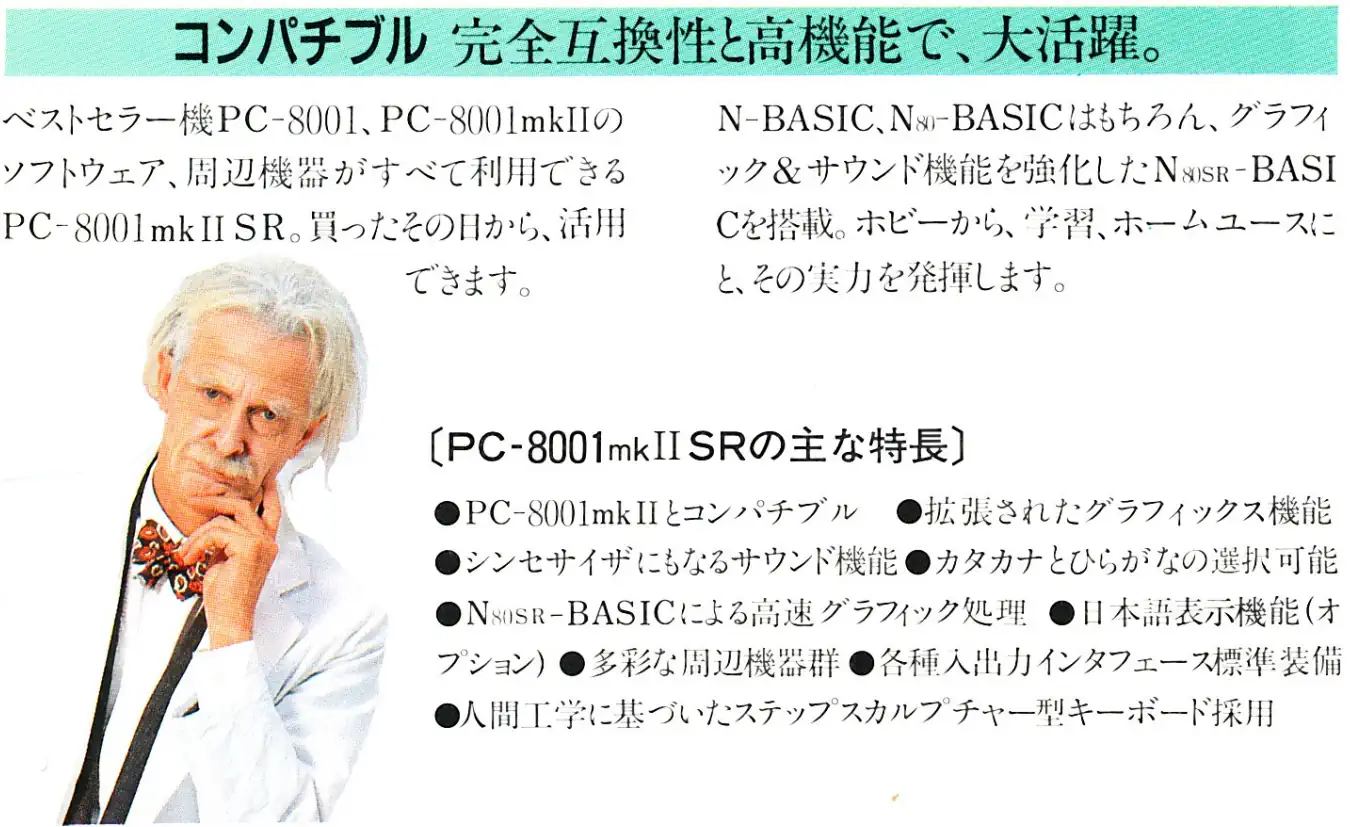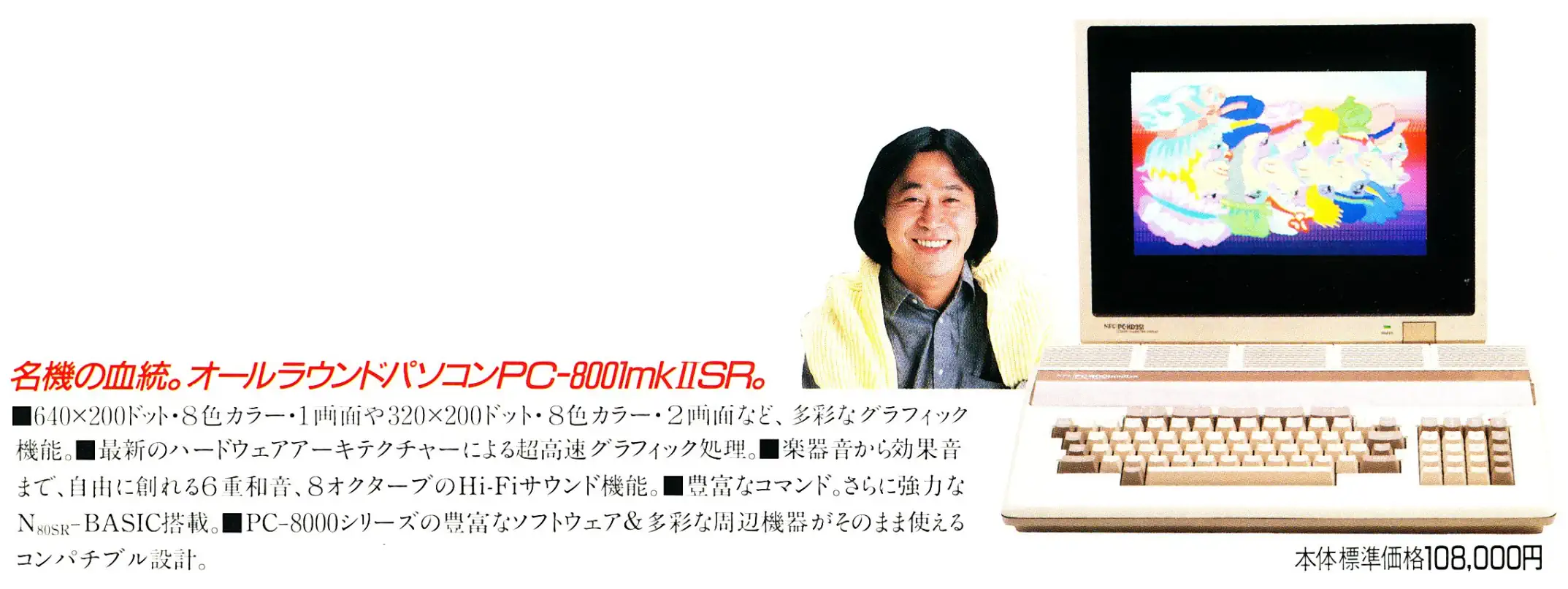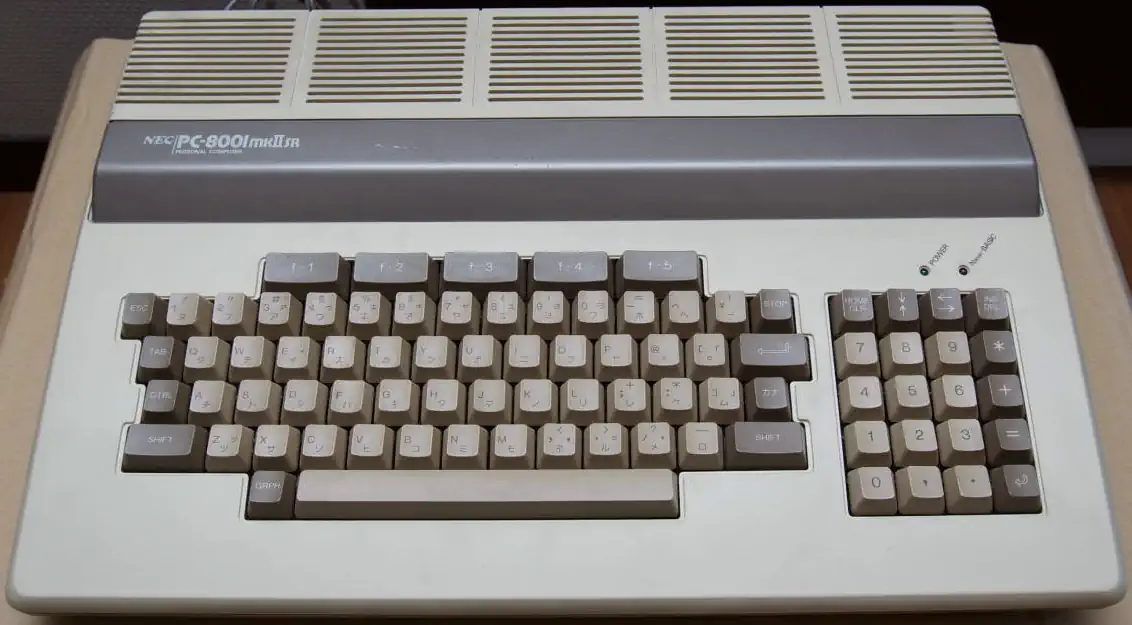NEC PC 8001 MK2 SR
The NEC PC-8001 mkII SR is the last in the PC-8001 series. It ran on the PC780C-1 Z80 compatible CPU clocked at 4MHz. The machine had 40kByte of N80-SR-basic, 32kByte of N80-Basic, and 8KByte of N-BASIC ROM for backwards compatibility with previous machines.
The mkII SR came with a new sound chip, the Yamaha YM2203 which was capable of three channel mono FM synthesis, and it also had 3 PSG channels, making the sound capabilities superior to its predecessors.


Yamaha YM2203 FM Sound Chip
The Yamaha YM2203 is an FM Operator Type-N (OPN) chip. It is a six channel sound chip developed by Yamaha. There are 3 FM and 3 SSG channels. The Yamaha OPN family of FM chips is used in many computer systems and video games throughout the 1980s and the 1990s. It was used in later editions of the NEC PC-8800 line of computers, some Sharp computers and many arcade game machines.
The YM2203 generates sound via frequency modulated sine waves. There are 12 different cells that each generate a 13-bit sine wave at a programmable frequency. The volume of each sine wave is controlled by a programmable ADSR envelope generator. The output of these cells can be summed by a mixer, or fed into the input of another cell creating up to 4-cell batches that create the final sound of a channel. Each channel can use 4 cells, for a total of 3 FM channels. Various combinations of ADSR parameters, multipliers and other settings make up the instrument patches, these are FM generated representations of sound that resemble certain intruments.
The SSG module of the YM2203 is basically an implementation of the YM2149 SSG chip, that was included on the YM2203. It has three wave channels and a noise generator.
A YM3014 Digital to Audio Converter (DAC) was used with the YM2203 to generate the audio signal.

Block Diagram and pin layout of the YM2203

Zilog Z80 CPU Family
The Z80 quickly became popular in the personal computer market, with many early personal computers, such as the TRS-80 and Sinclair ZX80, using the Z80 as their central processing unit (CPU). It was also widely used in home computers, such as the MSX range, SORD, and the Amstrad CPC, as well as in many arcade games. Additionally, it was also used in other applications such as industrial control systems, and embedded systems. The Z80 was widely used until the mid-1980s, when it was gradually replaced by newer microprocessors such as the Intel 80286 and the Motorola 68000.
The Z80 microprocessor was developed by Zilog, a company founded by Federico Faggin in 1974. The Z80 was released in July 1976, as a successor to the Intel 8080. It was designed to be fully compatible with the 8080, but also included new features such as an improved instruction set, more powerful interrupts, and a more sophisticated memory management system.
The Z80 quickly became popular in the personal computer market, with many early personal computers, such as the TRS-80 and Sinclair ZX80, using the Z80 as their central processing unit (CPU). It was also widely used in home computers, such as the MSX range, SORD, and the Amstrad CPC, as well as in many arcade games. Additionally, it was also used in other applications such as industrial control systems, and embedded systems. The Z80 was widely used until the mid-1980s, when it was gradually replaced by newer microprocessors such as the Intel 80286 and the Motorola 68000. The design was licensed to Synertek and Mostek as well as the European SGS.
The Z80s instruction set is binary compatible with the Intel 8080, so that 8080 code such as the CP/M Operating System and Intel's PL/M compiler for the 8080 can run unmodified on the Z80. The Z80 had many enhancements over the 8080 such as 16-bit data movement instructions, block copy and block I/O instructions, single bit addressing of all registers, IX/IY offset registers, better interrupt system and a complete duplicate register file for context switching during an interrupt.
Source: WikiPedia

ROM: 84kB
VRAM: 48kB Sound Chip Yamaha YM2203 Sound 3 fm channels, 3 PSG channels Display Chip none Display 640x200 8 colors
320x200 double buffer Best Color 8 colors Best Graphics 620x200 in 8 colors Sprites n/a System OS N80 SR-BASIC in ROM Original Price 108000

